July 2019 was another very changeable month weather-wise in this part of the world, with daytime temperatures fluctuating wildly between 12c and 29c, and just about every type of weather except snow, including an end of month mini heatwave, being experienced.
However, by being flexible with our days and timings, and by planning our itineraries round the weather, it turned out to be a very enjoyable and pretty successful month for wildlife sightings, and although the days are shortening slightly now, this far north there are still around 18 hours of usable daylight.
Full-day (6-8 hours) safari bird species day lists dropped a little, down into the 40's, as some of our wader species moved away from their upland breeding territories to the coasts, and bird-wise things have definitely quietened down , as just about every species seems to have successfully raised and fledged youngsters now.
Mammal day lists varied between 4 and 9, depending on the length of day, and variety of habitats visited...with early starts generally producing more and closer sightings, with again, many species seen with youngsters..
With plenty of sunshine between the showers, the heather starting to turn a beautiful vivid purple, and the wild flowers and butterflies at their most abundant, the Cairngorms National Park really was a beautiful and unspoilt place to be, and my safari clients, from all around the world, including China, USA, Australia, India, Italy, France , Belgium, Holland and all over the UK certainly seemed to enjoy themselves.....as did I......
 |
| A local moorland and loch |
To give you an idea of what you may realistically hope to see if you are planning a future July visit yourself, I hope the following more detailed information, illustrated with photos taken this month (and in previous July's) in and around the Cairngorms National Park (and occasionally beyond) by myself, my friends or my safari clients (thanks for the photos everyone!) will help - clicking on the picture enlarges it to full screen.
Local speciality and upland bird species seen regularly throughout the month included:
Osprey, Red Grouse, Slavonian Grebe, Goldeneye and Dipper.
We also enjoyed some good views of Ring Ouzel, Red-Throated Diver and Black-Throated Diver early in the month, though they became less frequent later on, a few reasonable sightings of Golden Eagle, Crested Tit and Crossbill, though they were far from reliable, and unusually, one low level encounter with a Snow Bunting.
Sadly, but not unusually, White-Tailed Eagle, Capercaillie and Black Grouse were not seen at all on my safaris this month....
Mammals seen regularly locally during the month included: Red Squirrel, Rabbit, Brown Hare, Roe Deer, Red Deer, Reindeer and Mountain Goat, with just a couple of sightings of Mountain Hare and one brief glimpse of a Bank Vole....
July 2019 bird sightings in more detail:
 |
| Incredible Osprey image taken by top wildlife photographer Nigel Wedge (at a local hide) |
 |
| Juvenile Ospreys preparing to fledge by Bob Smith |
Our local Ospreys stole the show again this month, often being voted as 'Bird of the day' by my safari clients, with the adult birds seen fishing, delivering fish and nesting material, and feeding and encouraging the fast growing 'scaly' looking , orange-eyed youngsters to take their 'maiden flights', and by late-month they had indeed fledged and were seen perched and flying for the first time.. I can therefore highly recommend July as THE month for Osprey watching and photography in this area...
 |
| Slavonian (Horned) Grebe family by Bob Smith |
 |
| Parent Slavonian (Horned) Grebe feeding a well-grown youngster by Nigel wedge |
 |
| All aboard!! Newly hatched Slavonian Grebe chicks take a ride! By Rod Watson |
Our local pair of Slavonian Grebes, undoubtedly one of the UK's rarest and most beautiful breeding birds, very unusually, spent much of the month with the female on a second batch of eggs, whilst the male had to divide his duties between feeding the still very demanding well-grown youngster from their first brood and his nest-bound partner, and happily, by the last week of the month, we were delighted to see 3 tiny newly hatched chicks from their second brood for the first time....
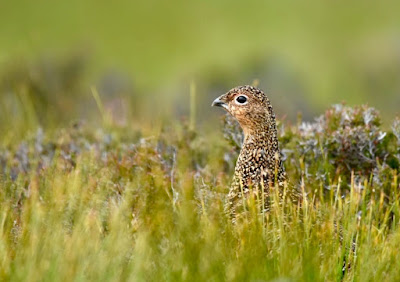 |
| Female Red Grouse by Brendan Meyerink |
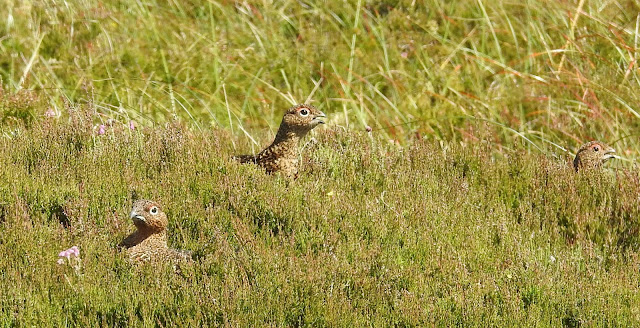 |
| Red Grouse family taking cover in the heather |
Red Grouse are always popular with my safari parties, as being a bird of largely uninhabited upland moors, most of my clients, especially those from abroad, do not have them close to home. We, however, are fortunate to have lots of suitable heather moorland in this area, and throughout the month we enjoyed good close up views of families of up to 6 of these very characterful and beautifully marked birds, though with the 'glorious 12th' rapidly approaching... I suspect they may not be quite so obliging next month...
 |
| Juvenile Ring Ouzel by Rod Watson |
 |
Adult male Ring Ouzel by Rod Watson
|
Ring Ouzels were seen in upland habitats near their nesting and feeding areas, at least early in the month, especially near the wetter areas with most worms, but became noticeably more elusive as the month progressed as they and their young began to roam even further afield, and it appeared that some may well have vacated this area and headed south for warmer climes by the end of the month....
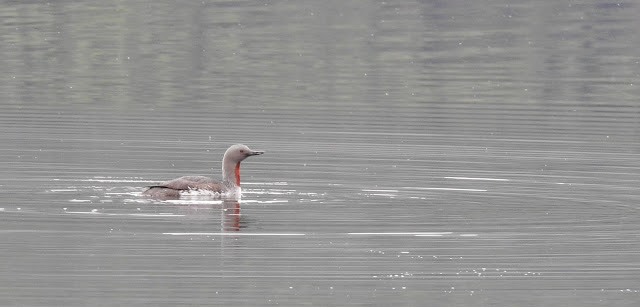 |
| Red-Throated Diver |
 |
| Black-Throated Divers |
Divers (Loons), being very rare in summer south of here, and looking resplendent in their dapper summer plumage are always popular with my safari clients, and we were fortunate enough to get some good views of both Red-Throated and Black-Throated early on this month, the former often with their rapidly growing youngsters on their favoured local lochs. It should be noted however, that they are rarely seen close to the shore, can be difficult to find in 'choppy' conditions, and are easily disturbed by non wildlife-friendly tourists dog-walking, swimming and boating etc, so the less windy days and early morning starts in search of them usually gave us our closest sightings, and sightings became noticeably less frequent as the month progressed, as some presumably moved out to the coast where they will spend the autumn and winter...
 |
| Goldeneye family |
Goldeneyes only breed in the UK in northern Scotland, and their numbers have increased greatly in recent years, mainly due to the RSPB providing nest boxes on trees around most local lochs - yes, they really are a duck that nests up a tree! - and we got to see many large families of these very attractive little ducks this month...
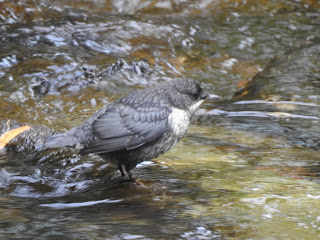 |
| Young Dipper |
Dipper sightings were a bit 'random' this month, with the birds seemingly quite mobile up and down the quite low level rivers, on some days, despite our best efforts, we saw none, and on other days we saw one or more on each river we visited! Which just goes to show that although local knowledge and experience are important, sometimes you need a bit of luck too......
 |
| Crested Tit |
Crested Tits were seen occasionally on our walks through Caledonian pine forests, usually in family parties, though there didn't appear to be any 'pattern' to our sightings, and I must stress again, that they can be very elusive in the spring and summer months, and knowing their distinctive rippling trills is a huge advantage in helping you to see these very 'flitty' little local specialities....which are incredibly difficult to photograph away from feeding stations by the way...
 |
| Juvenile Crossbill |
It was a similar story with Crossbills too, with the majority of our sightings being of the rather frustrating 'fly-over' variety, with them only being identified by their characteristic 'jip' 'jip' calls as they flew between different parts of the forests...but we did get lucky on a couple of occasions when birds perched briefly, allowing the rare treat of snatched views through a scope ...though unfortunately, a decent photo escaped me..
 |
| Golden Eagle (right) with Buzzard by Rod Watson |
Eagles are probably hardest to see in mid-summer (in this area at least), as the birds are still concentrating on fledging their young, and have so many hours of daylight in which to hunt, and sadly, but true to form, we only managed one good, close view and a few less good distant sightings this month......but if previous years are anything to go by, things should improve soon as the youngsters take to the wing....
 |
| Red Kite |
Still on raptors, we did however manage to see Red Kite, Common Buzzard, Kestrel and Peregrine reasonably regularly during the month...
 |
| Snow Bunting by Brendan Meyerink |
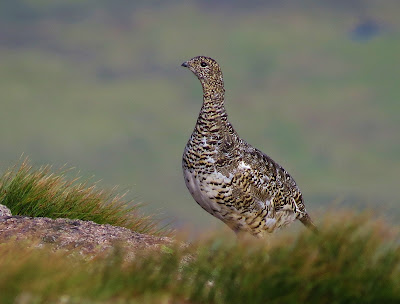 |
| Ptarmigan by Bob Smith |
 |
| Ptarmigan family by Bob Smith |
July is 'last chance saloon' for seeing all 3 of our mountain top species in one trip, as the Dotterel often depart in early August..and although days of suitable weather (dry, cloudless and not too windy) were not that frequent, on the one occasion we took to the hills to look for them , on a lung-busting, calf muscle burning walk up to the 4,000 ft summit from the ski car park at 2,000 ft, as the Funicular railway is still out of action..., just one family of Ptarmigan was seen (though they did show very well), and only one Snow Bunting obliged, with the Dotterel failing to show at all...
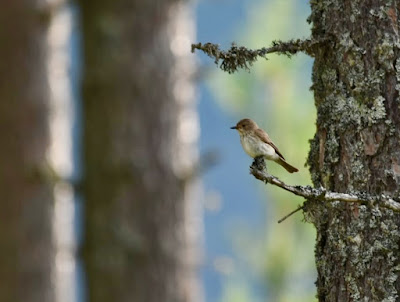 |
| Spotted Flycatcher by Brendan Meyerink |
 |
| Golden Plover |
Other 'good' birds seen or reported locally in Badenoch and Strathspey this month included:
A
Red-Necked Phalarope (which I missed!) , a
Rose-Coloured Starling (which I also missed!)
Golden Plover, and
Spotted Flycatcher.
 |
| Midsummer at a local river |
July 2019 mammal sightings in more detail:
 |
| Red Squirrel |
Red Squirrel was probably voted 'mammal of the day' most frequently by my safari clients this month, with many of them seeing these charismatic and undeniably cute little animals for the first time, and bringing home to me the fact that they are now very difficult to see in the UK, being confined mainly to the northern Scottish Highlands, with just a few small localised populations remaining in other areas...
 |
| Feral Mountain Goats |
Similarly, we also had regular good views of large groups of another scarce and very localised mammal, the feral
Mountain Goat.. interesting animals, that seem to like remote upland areas, and come in a wide variety of colours, from white, through grey and brown to black, or sometimes a mixture of all of these...
 |
| Red Deer hinds with a very cute youngster |
Another 'Highland speciality',
Red Deer were seen regularly in local upland glens, usually in large same-sex herds, the stags happily feeding and seemingly relaxing, and the hinds with their fast-growing young always nearby ....with many of my safari guests from far-away lands putting these iconic beasts high up on their 'wish-lists'....
 |
| Roe Deer |
Though
Roe Deer are actually quite common and widespread across the UK, their shy, nervous disposition means that they are more frequently found in quieter, less disturbed places, especially at dawn and dusk, meaning that most members of the general public rarely encounter them...but we see them most days, especially if we make a reasonably early start...
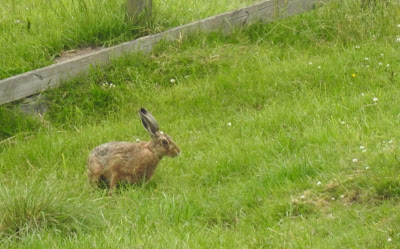 |
| Brown Hare |
The same could also be said of
Brown Hares, with most of our sightings coming early in the day before too much human disturbance, and generally on the more remote areas of open farmland...
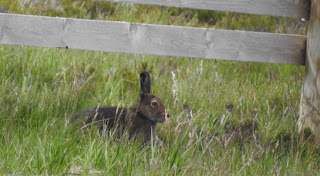 |
| Mountain Hare |
Mountain Hares too are actually pretty tricky to find, certainly outside of the winter months, especially in their 'summer camouflage' coats of mottled brown and grey, and most of our sightings were 'random' encounters on mountainsides or high moorlands, whilst in search of the special birds of those habitats..
Other wildlife:
 |
| Comma |
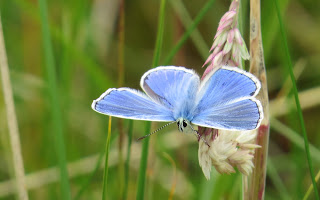 |
| Common Blue |
 |
| Scotch Argus |
Butterflies of several different types were seen regularly, on the sunnier days at least, with the more common species now being joined by our 'local speciality' the
Scotch Argus towards the end of the month...
 |
| Leaping Atlantic Salmon |
The recent rainfall and corresponding rise in water levels allowed the Atlantic Salmon to make their way further up our local rivers, and visits to popular local falls and 'leaps' can give great views - and for those with LOTS of patience, even the odd photo opportunity, as these amazing creatures attempted to fight the powerful flows and often steep ascents, to return upstream to their birthplace breeding grounds to reproduce...a highly recommended wildlife experience....
 |
| The view from Cairngorm Mountain summit |
So my 'sum-up' for this month is ... although the bird breeding season is almost over, July is still a pretty decent month to see a good selection of birds, animals and butterflies in this area,
with no need for a really early start, and it's also good for a mountain-top adventure, or a trip to a seabird colony with (usually) fairly good weather, and all still with plenty of daylight hours....
I must confess though, that I always tend to feel just a little sad at the end of every July , as I know that many of our summer visiting birds are soon to vacate our area and fly south to warmer climes as summer turns to early autumn next month.....
 |
| Sunset at the Moray coast |
I know a lot of visitors to this area very wisely check out reviews of attractions at tripadvisor before 'taking the plunge' and booking - if you wish, you can check out my clients comments at the link below....
https://www.tripadvisor.co.uk/Attraction_Review-g186537-d3335134-Reviews-Highland_Wildlife_Birdwatch_Safaris-Aviemore_Aviemore_and_the_Cairngorms_Scottish.html
If you think you know someone who may enjoy a taste of what I do, why not treat them to a safari gift certificate. They make a thoughtful and imaginative present, are available for any amount and are valid at any time within a year from date of purchase....

















